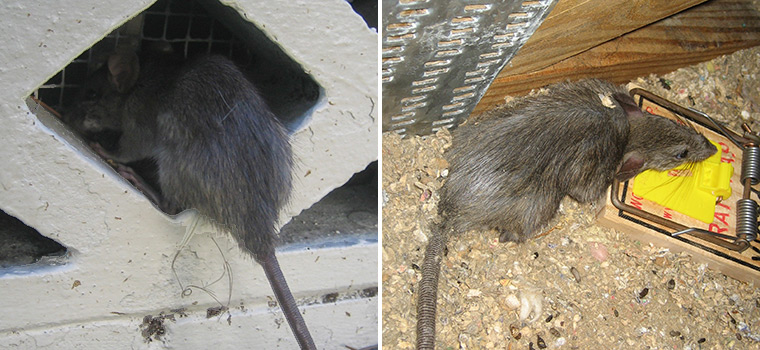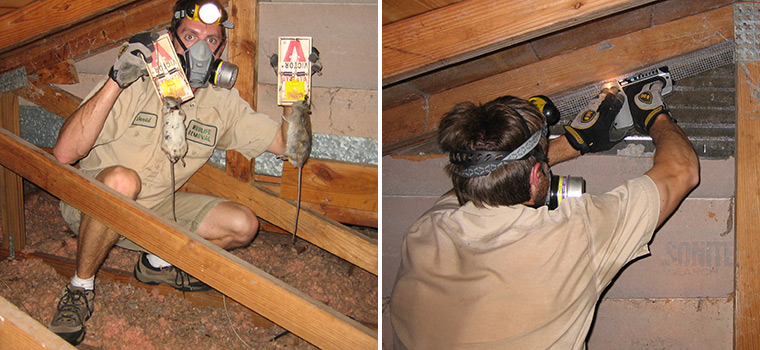-
info@aaanimalcontrol.com
Call us for help in your town
Humane Wildlife Education
Rats in the Attic - How to Get Rats Out of Your Attic
Rats in the attic is a common challenge throughout the United States. If you hear scratching in your attic, or the pitter-patter of feet up and down the walls or above the ceiling in your house, and the noise is coming at night, it's most likely rats or mice. Daytime noises are more likely squirrel, and raccoons sound larger. Do an inspection of the attic to verify the species. Rat droppings are much larger and thicker, averaging 3/8 inch, while mouse droppings are quite a bit smaller than grains of rice. Here are the 11 steps to get rid of rats in the attic:
- Inspect your attic to verify the rats, and the level of infestation, and areas of high activity
- Inspect every inch of the outside of your home or building to find rat entry points
- Pay attention from ground to roof, including all vents, pipe entry, gaps in the architecture, etc.
- Seal shut every entry hole you find, with steel repairs and caulk to seal off air flow
- Set at least a dozen Victor Easy Set snap traps in the attic, in areas with rat feces and trails
- Bait doesn't matter as much as location, but peanut butter on the pan is good
- Remove trapped rats every day, and reset traps and monitor the catches
- When you are catching no more rats, and hear no more noise, the problem is solved
- If you still have a problem, you failed at step 2. Start again, and find that last entry hole
- After the rats are all gone, you might want to consider attic cleanup and decontamination
- It's hard. You might want to click here for our rat pro in your area and get the job done right
After you read the below information, you may be able to do it yourself, but if you want to hire us to professionally solve
your rat problem permanently, you might want to read How much does our rat removal cost? to get the lowdown on prices.

Left image: a rat entry area - Right image: a snap
trap set in the attic in an area of rat activity.
How to get Rats out of your attic - While
you may not think much about it, your attic
is the ideal place for little creatures like
rats. Think about it. You probably rarely go
into your attic, it's warm and dry, and there are usually lots
of great places to hide and make a nest. The
insulation alone is the perfect material to
start building a nest out of. It is warm and
soft, and a rat is not worried about a
little fiber glass in its lungs when it is
only going to live for a brief time.
The problem with rats in your attic is that
it is rarely ever just one. Rats love to
live in large communities, so when you have
a rat infestation, you truly have a major
army there. A community of rats can be as
many as 100 or more, depending upon how much
food and space is available. Because the
attic is usually so spacious and
unencumbered the only thing standing in the
way of the rats success if food.

Left image: me removing rats trapped in an
attic - Right image: sealing shut a gable
vent entry area, from inside the attic
This means that the attic has to be your
primary area of offense if you are going to
rid these creatures from your home, but you
have to have a very smart plan. I want you
to consider that if you simply cause the
rats to scatter and don't deal with the
problem in an intelligent way you will have
rats running to every place they can find
refuge in your home and on your property.
Now you don't just have a big problem in one
place; you have a whole lot of smaller
problems all over the place. This is why a
carefully, well thought out plan is
essential.
Where you want to begin is by finding where
the rats are coming into the home. You need
to make sure you find every entry point,
because if you miss even one you are still
giving them a way to get into your home.
This means they will keep getting in and you
will truly never solve your problem. Look
for every place you can find where there is
a small crack, slit, hole or gap in your
home. This includes around spaces like vents
and where hoses come into your house,
especially near your dryer. Look for gnawing
marks because this can be a sign to you of
where they are getting in.
If you do find places like this you want to
make sure that you seal them well. Sealing
should be done with steel wool. This is
especially hard for the rats to chew
through, and is actually quite painful for
them to do so, meaning they will leave those
places alone and you have removed the places
they are getting in.

Rats can be caught in live cage traps, but
there's no point - they can't be relocated
outside alive. They won't survive.
It may seem odd to you to seal them all
first, but this is the where you need to
begin. If you leave those holes open and
scare them out, by the time you get around
to closing them all up you can be sure that
some if not many will have returned.
Your next step is to put up traps all around
the attic. Traps can be live ones if you
wish to catch many at once and give the rats
a new home somewhere else by releasing them
at another location, or you can choose traps
that will end the lives of the rats. There
are three primary kinds of traps that will
do this. The first is the standard looking
mouse trap that most of us are familiar
with. The difference with the rat model is
that the much more force is released in the
trap. A mouse trap would just injure a rat,
and so more force is needed.
There are traps that are much like fly
paper. The rat steps on the trap and its
little paws get stuck. There is a small
amount of poison in the paper and as the rat
gnaws at it the poison is eating and it
dies. Even if the paper is not eaten the
poison is secreted through the skin causing
death. I do NOT recommend any kind of
poison, or sticky glue traps. There is no
point. They are ineffective compared to snap
traps. In addition, they are far less
humane.

The last kind of a box poison trap. This is
like the roach motel idea. A rat goes inside
the box where there is a tasty morsel. The
treat is actually laced with poison, so that
when the rat eats the treat it dies. Once
three of four have died in the box, you
simply throw out the box and put out a new
one. Again, I DO NOT recommend this type of
trap. A snap trap is far more effective. You
want to solve the problem. Use the right
tool. Never use poison or gimmicky traps.
The Victor Easy Set snap trap is the best. I
am not paid to endorse that trap, it's just
that I've been doing this for a decade, in
hundreds of attics, and the wooden snap trap
is the most effective tool, by far.
Whenever you remove traps be sure to wear
gloves and a mask. Rats carry many parasites
and disease with them, and so this is a
great way to safeguard your health.
You may want to consider putting used kitty
litter near places you have found where they
are entering your home on the theory that
rats hate cats, and that smell is enough to
keep them away. However, it doesn't work
that way. Rats won't leave because of a
repellent. If they leave their only habitat,
they die. The only way to solve the problem
is to seal shut entry holes. That's it.
 Click for my raccoon removal photo gallery.
Click for my raccoon removal photo gallery.
Over 60 photographs of actual rat removal jobs I've done.
 Visit my awesome opossum trapping blog!
Visit my awesome opossum trapping blog!
Over 25 examples of specific raccoon control jobs I've done. Get ideas!
For more rat removal articles, click any of the below:
rat poison
mice in the attic
how to kill rats
how to get rid of rats
Do rats like dog poop?
What Should I Do with a Rat After I Catch It?
Rat diseases that affect humans
What Kind Of Damage Do Rats Cause In An Attic?
Will the City or County Animal Services Help Me with A Rat Issue?
What Can Rats Climb?
Do rats make chirping noises?
Do rats chew on wires? Why?
What Diseases Do Rats Carry?
Are Cage Traps a Good Option for Rats?
Black pepper and rats
Do rats bite humans in their sleep?
What Is the Best Bait to Trap a Rat?
Do rats come out in light / avoid light?
Will a Rat in the Attic Have a Nest of Babies?
Do rats attack human necks?
The bottom line is that getting rats out of the
attic is not always easy, especially depending on
the condition of your house. If you have an older
home in disrepair, or one with many architectural
openings, or an elevated home off the ground with
openings underneath, or a plumbing issue, solving
the rat problem could be very difficult. You
absolutely must find all entry holes and seal them
shut with steel repairs. Nothing else matters. Our
wildlife removal experts have seen it all, and are
experienced at understanding house architecture and
plumbing and they can find every last entry area in
order to solve the problem. If you are unable to do
it yourself, I recommend that you click
here to hire one of our rat pros in your town.
We get rid of rats in the attic in every city and
town in the USA, with over 1000 qualified rat control experts listed on this site.


















